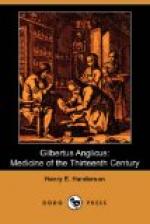The spleen, Gilbert says, is sometimes the name of an organ, sometimes of a disease. As an organ it is spongy and loose in texture, and attracts and retains the superfluities of the black-bile, expelled from the liver for its own cleansing. Hence it is a servile and insensitive organ, and accordingly suffers different diseases, such as obstruction, tumors, hardening, softening, abscess, and sometimes flatulence or repletion. The symptoms and treatment of each of these morbid conditions, arising from either heat or cold, are discussed with exasperating thoroughness, and the chapter concludes with the composition and use of various specific remedies of compound character, bearing the impressive titles of Dyasene, Dyacapparis, Dyaceraseos (a mixture of cherry juice, honey, cinnamon, mastic and scammony) and Agrippa.
Scrofulous swellings are carefully considered in a chapter entitled “De scrophulis et glandulis.” “Scrophulae and glandulae are hard swellings developing in the soft parts, as in the emunctory localities of the veins and arteries, particularly in the neck, armpits and groins, and sometimes in other places. They spring from the superfluities of the principal organs, which nature expels, as it were, to the emunctories and localities designed to receive this flux.” ... “Hence they are often found the cause of scabies, tinea, malum mortuum, cancer, fistula, etc., and are called glandes. Sometimes, however, a dryer matter is finely divided and falls into several minute portions, from which arise many hard and globular swellings, called scrofulae from the multiplicity of their progeny, like that of the sow (scrofa). The disease is also called morbus regius, because it is cured by kings.”
Gilbert advises that these swellings should not be “driven in” (repercutienda), but brought to suppuration generally by emollients and poultices. When softened they may be opened with a lancet and the pus allowed to escape gradually, but as this process is tedious, he prefers the entire removal of the glands with the knife, premissing, however, that no gland should be cut into which cannot be well grasped by the hand and pulled from its seat. This surgical manipulation is fully described, and is undoubtedly taken from the similar chapter of Roger. It is worthy of notice also that just at the close of this chapter, Gilbert mentions a swelling called “testudo,” a gland-like, gaseous (ventosa) tumor, usually solitary and found in “nervous” localities, like the joints of the wrist and hand. He says it often occurs from fracture (cassatura?) of the nerves, is cured by pressure, friction or incision, but is not entirely free from danger. Possibly this may refer to ganglion. Now, Roger makes no mention whatever of “testudo,” while Roland says:
“Nota quod quamvis Rogerius non designat inter glandulum et testudinem, scias igitur quod testudo fit ex majori parte flegmatica, minori melancholie, glandula vero a contrario,” a statement which might readily suggest the suspicion that Gilbert had before his eyes the text of Roland, or that, at least, he had not acquired his knowledge of testudo from Roger, his usual surgical authority.




